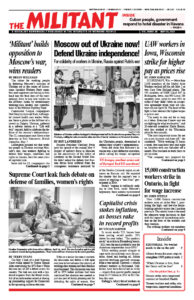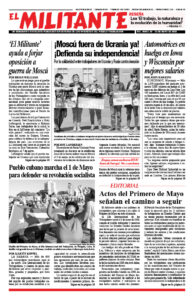May 26, 1997
HAVANA, Cuba — “Where did you serve on your first mission as an internationalist?” Cuban journalist Luis Báez asks Ulises Rosales del Toro, division general of Cuba’s Revolutionary Armed Forces (FAR) and chief of staff of the FAR.
“In October 1963, in Algeria, as chief of staff of the Tactical Combat Group during the war Morocco launched with the goal of forcibly annexing sections of Algerian territory,” the Cuban general says.
The Algerians has recently gained their independence from France, he continues. “They had just begun to govern the country, and their armed forces had not been fully established. Algerian president [Ahmed] Ben Bella asked for Cuba’s help.
“It was my first trip abroad and my initial contact with the revolutionary movement in another country,” says Rosales. He was 21 years old then.
May 26, 1972
As President Nixon’s trip to the Soviet Union on May 22 approaches, the Vietnam war is reaching a critical juncture. The Vietnamese people, struggling for control over their own lives, face grave threats from two sides.
On the one hand there is the United States pounding Vietnam with a considerable part of its naval and air power. There is no way of knowing how far the U.S. war makers are prepared to go. On the other hand, there is the danger that the Soviet Union, in a deal with Nixon, will try to pressure the Vietnamese to give up at the conference table what they have won on the battlefield.
In this situation the antiwar movement can play a historic role through its struggle for immediate U.S. withdrawal and self-determination for the Vietnamese. The masses of the American people have the power to stop Washington’s aggression.
May 24, 1947
OAKLAND, Calif. — Wild enthusiasm broke loose in the Oakland Voters League headquarters when the election returns showed a clear majority for four of the five League candidates. In spite of a tremendous barrage of red-baiting propaganda, the newly formed Voters League, working through the trade unions, was able to defeat the powerful, well entrenched and experienced political machine.
The issue which kept the sides sharply divided was the Kahns and Hastings strike. The strike of the two department stores posed the question “which side are you on” to every trade unionist and large sections of the middle class.
The Socialist Workers Party came out in active support of the Voters League slate. Although critical of the candidates and their mild reform program, the SWP saw the possibility of a labor party movement growing out of the campaign.

